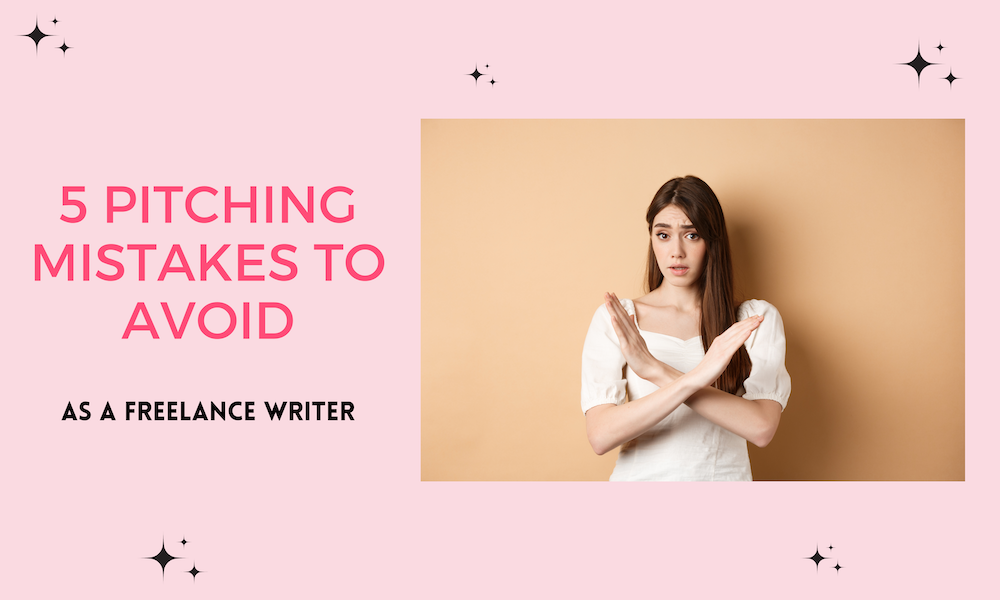Tons of resources out there talk about what exactly to include in your pitch. But few mention what not to do.
As much as we wish otherwise, editors simply don’t have the time for poorly written pitches. Plus, email etiquette is especially important, as it’ll increase your chances of commissioning stories (and hopefully building rapport with the publication!).
So, before you hit “send”, make sure you don’t make one of the following mistakes when writing your freelance pitch.
#1: Don’t Make Your Pitch About You
An editor’s goal is to stay employed. Sorry to be frank, but it’s true. Listen, you can have a life-changing story that means a lot to you personally, but it also has to appeal to the publication. Editors commission articles that align with their company’s objectives and (hopefully) boost its reputation. So, find a way to make your story about them.
How do you do this?
Well, it starts with figuring out how your story will serve the publication’s readers. What new insights are you bringing into an existing conversation? How will the takeaways in your story help the readers improve their lives in some way? Ask yourselves these questions and determine your story angle accordingly.
To be clear, you should still share a little bit of personal background information at the end of the email. In 2-3 sentences, talk about what you do, link relevant clips or your portfolio, and mention any hobbies or interests.
#2: Don’t Send the Same Version of a Pitch to Different Editors
This should go without saying, but copying and pasting the same version of a pitch and sending it to 30+ editors is self-sabotage. Editors know when emails aren’t personalized and they won’t take pitches seriously in these cases.
Always do your research beforehand. Read a few articles in the publication to get an idea of the tone, topics covered, and target audience. Figure out whether the editor has a special area of focus (i.e., Gen Z entrepreneurship, wellness trends, pet health) and angle your story around that. If you really want to make a solid impression, mention an article or two that resonated with you.
When editors see that you’ve taken the time to do a little homework, it takes some of the pressure off of them. Also, refer to your editor by their first name in the email!
#3: Don’t Send Completed Story Drafts
Unless the publication specifies otherwise, do not send a first draft of your story to the editor. First of all, they don’t have the time to read through an entire story. Also, the story draft you send in might not align with the angle or focus the publication looks for. And finally, many pitching guidelines explicitly state to not send completed drafts.
Save yourself the time of writing an entire story and wait for the editor’s guidance.
Even if you already have the piece written, it’s better to pitch the idea and make revisions once you hear from the editor.
#4: Don’t Make Your Email Hard To Read
Ever since I’ve learned about UX, I’ve realized just how off-putting poor design can be (just as much — if not more — than poor grammar!). Don’t include any images (unless requested), large blocks of text, or complex fonts in your email. The editor will likely be skimming your pitch, so you want to make it easy for them to do so.
Also, break up paragraphs into smaller chunks (I like to alternate between shorter and longer ones). This improves the readability of your email and helps cluster ideas into more digestible bits.
#5: Don’t Follow Up More Than Once
I’m not gonna lie, it can be frustrating when you put all that time into perfecting your pitch to hear… nothing.
Editors are human beings. They forget to reply. They accidentally delete messages. They lose emails in the endless barrage of virtual mail they receive.
Pitching is ultimately a numbers game, and it’s highly unlikely that you’ll hear back from every single editor you pitch. Think of the follow-up as your second shot. Sometimes, reaching back out the editor can lead to a story commission (it’s worked twice for me so far!).
Follow up once, and if the editor still doesn’t respond, try sending the story elsewhere. Continuously emailing them can come off as desperate (and annoying, to be honest). Don’t ruin your chances of potentially working with this editor and keep things professional. Most of the time, rejection isn’t about you or your story idea, but a sign that your story just isn’t a right fit for that publication.
I’d suggest keeping a spreadsheet so you can track when you sent the first pitch. Two weeks later, if you still haven’t heard back, send a follow-up email. No need to complicate things. Try a variation of this:
“Hey [Editor’s Name],
I sent you this pitch a couple of weeks ago and wanted to circle back.
Let me know your thoughts! Hope to hear from you soon.
Best,
[Your Name]”
For More Pitching Tips…
Pitching editors can be daunting when you’re a beginner, and you’ll likely try different tactics before finding one that works. However, with the tips above, you can save yourself the guesswork and maximize your chances of landing that next big byline.
If you’d like to learn more about pitching — and even get your hands on a pitching template and accepted Business Insider pitch! — let me tell you about The Freelance Writing Roadmap.
This free 11-page guide goes in depth about where to find writing jobs, helpful resources for sharpening your writing skills, and how to polish each pitch you send to editors.
Click the banner below to grab your free copy! And happy pitching!


